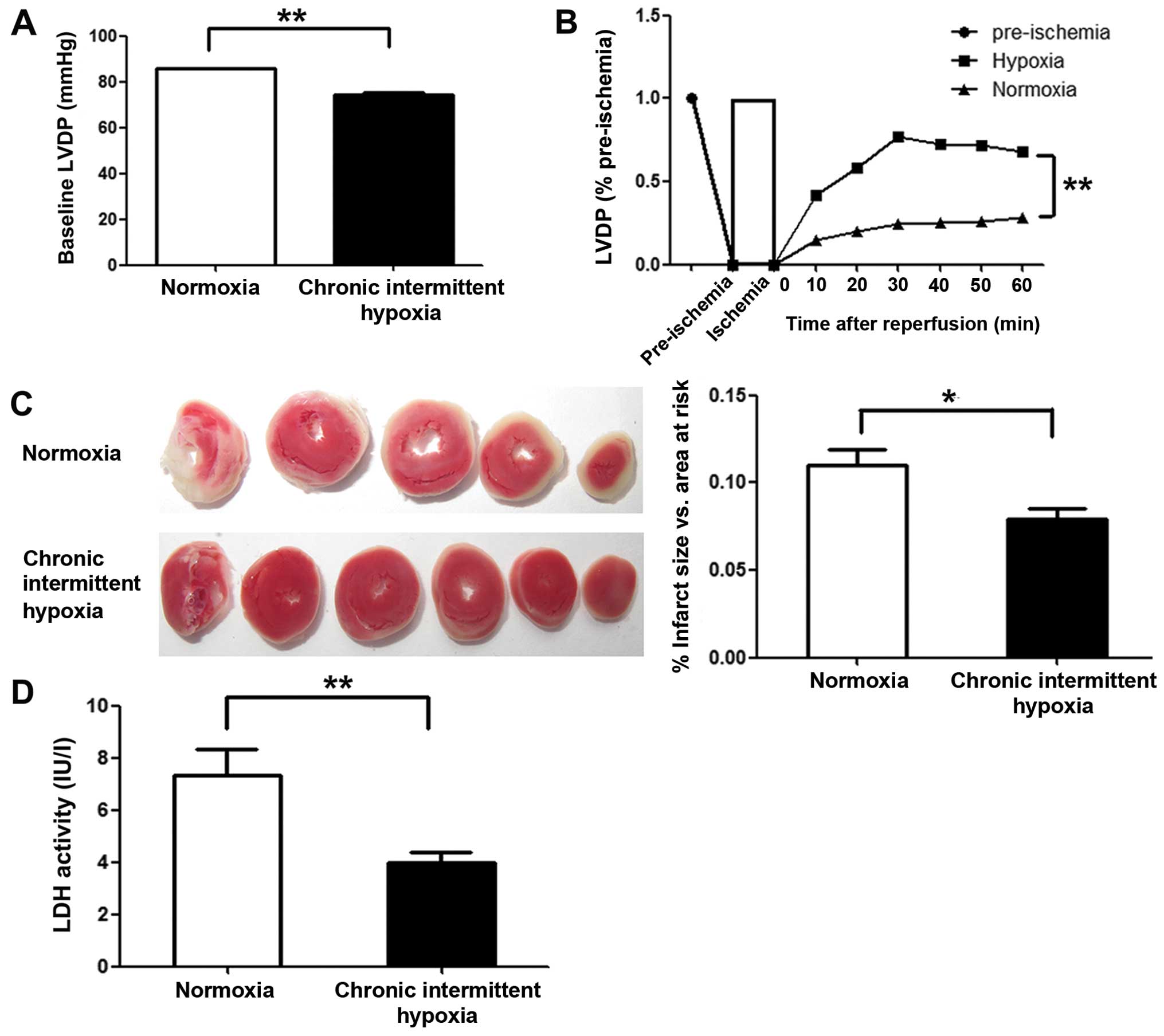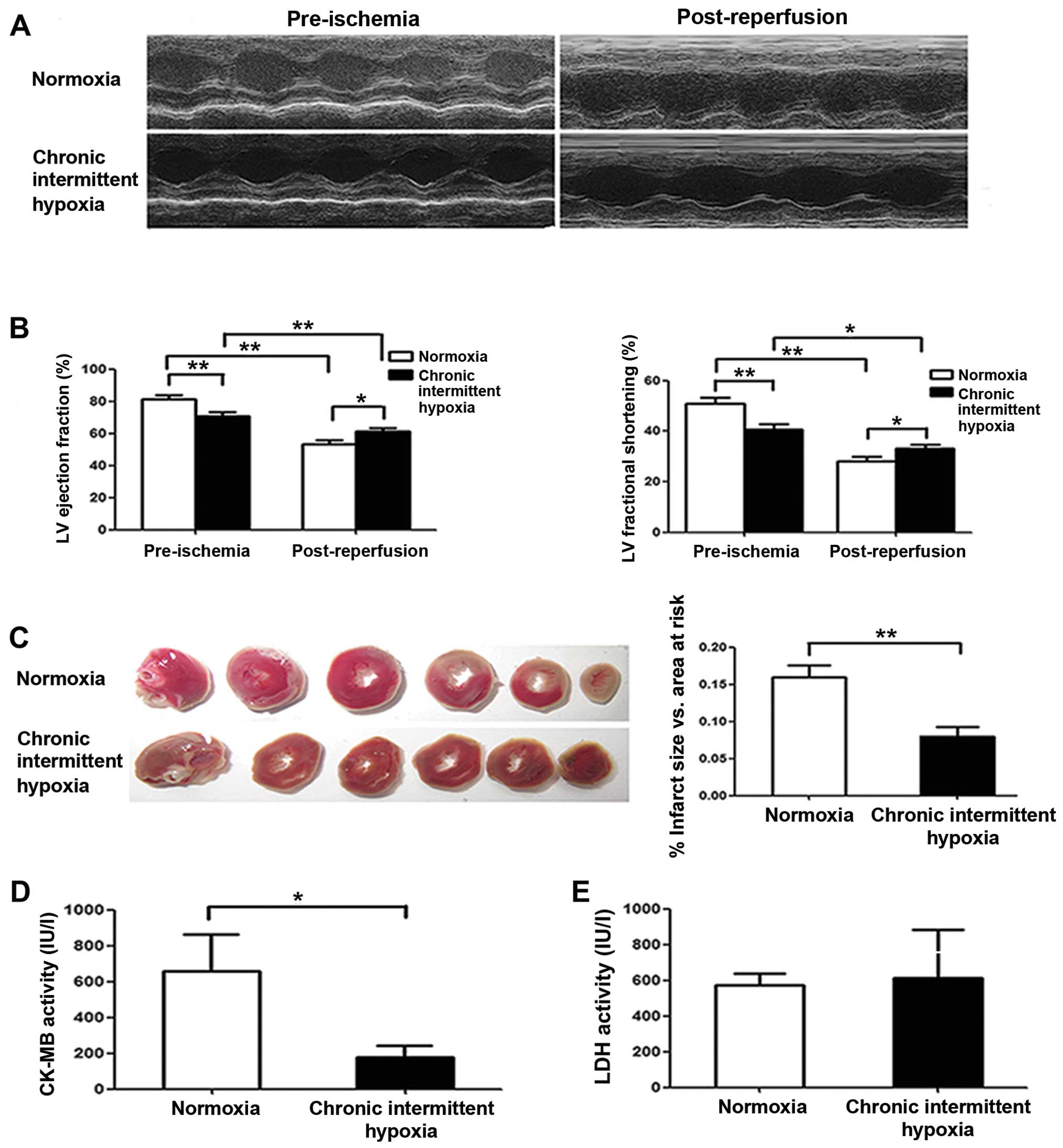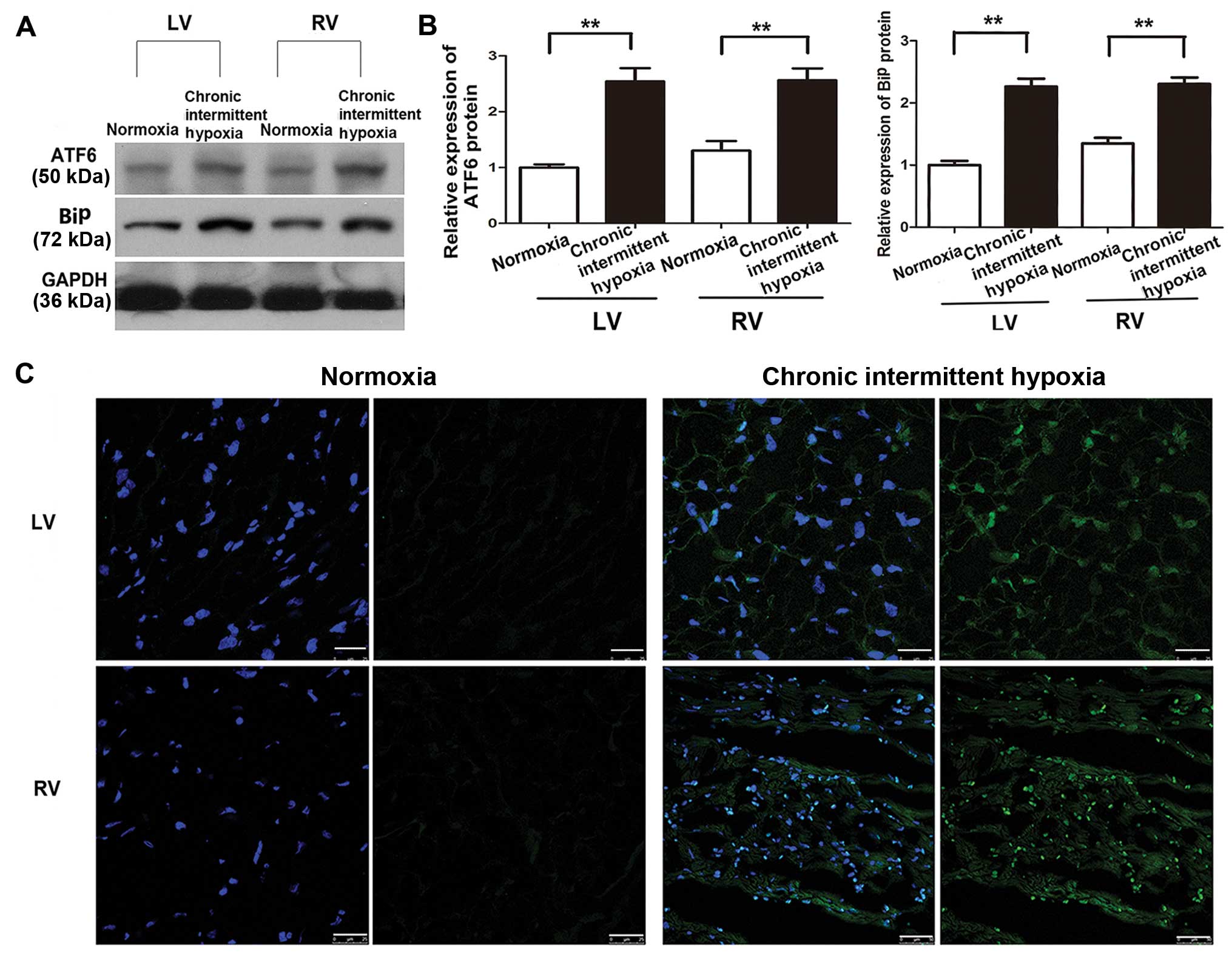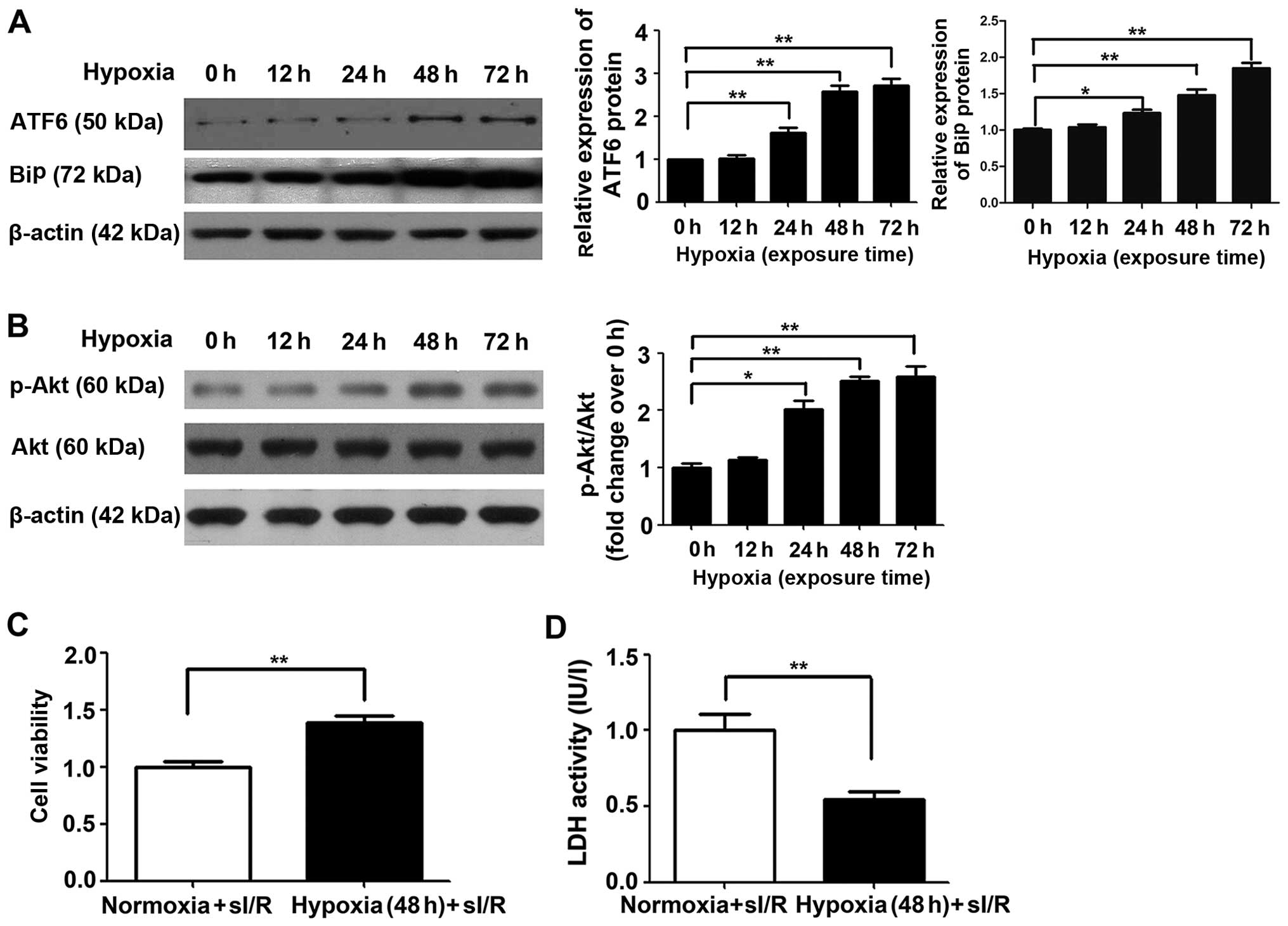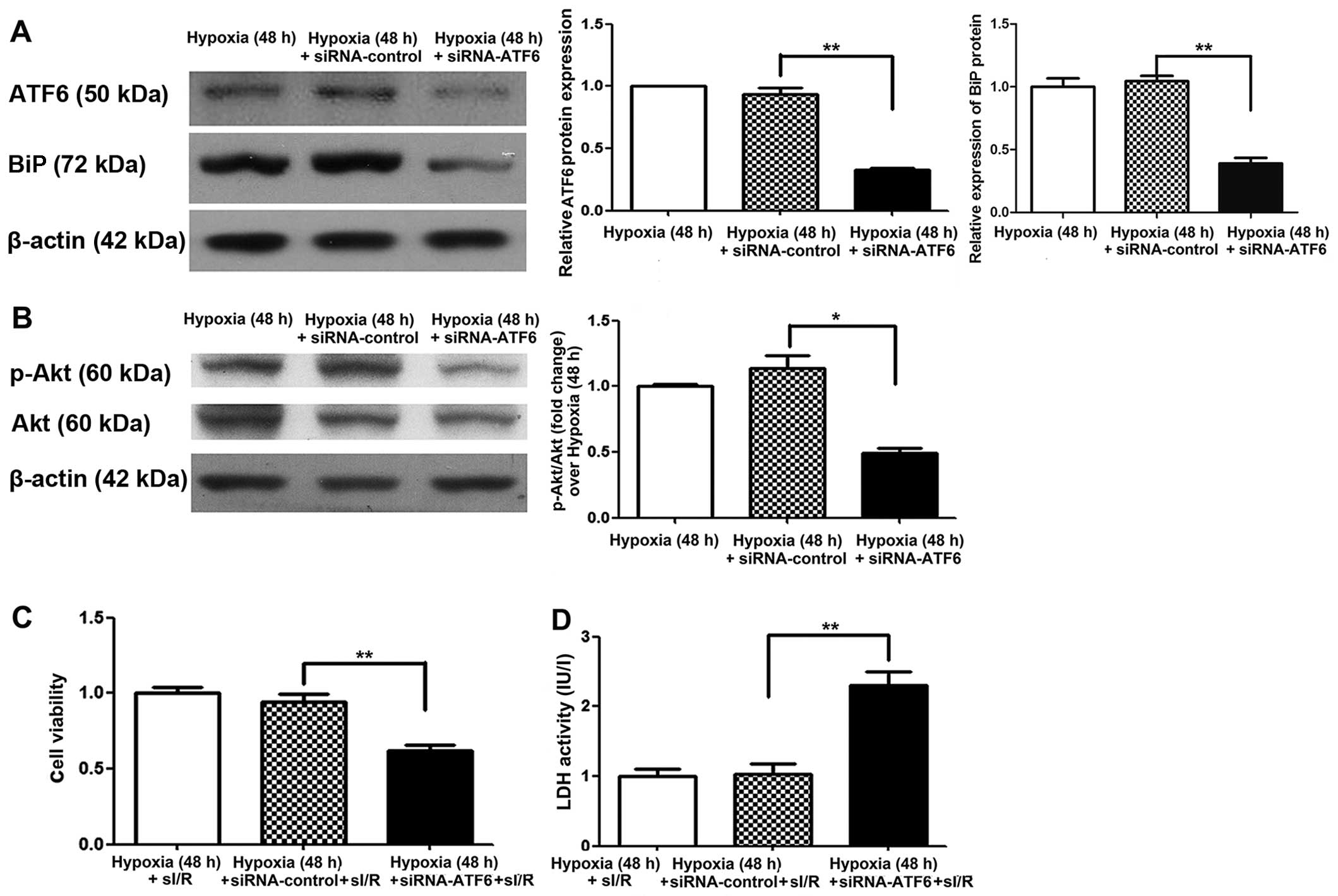|
1
|
Faeh D, Gutzwiller F and Bopp M; Swiss
National Cohort Study Group: Lower mortality from coronary heart
disease and stroke at higher altitudes in Switzerland. Circulation.
120:495–501. 2009. View Article : Google Scholar : PubMed/NCBI
|
|
2
|
Hu Y, Sun Q, Li Z, Chen J, Shen C, Song Y
and Zhong Q: High basal level of autophagy in high-altitude
residents attenuates myocardial ischemia-reperfusion injury. J
Thorac Cardiovasc Surg. 148:1674–1680. 2014. View Article : Google Scholar : PubMed/NCBI
|
|
3
|
Neckár J, Papousek F, Nováková O, Ost'ádal
B and Kolár F: Cardioprotective effects of chronic hypoxia and
ischaemic preconditioning are not additive. Basic Res Cardiol.
97:161–167. 2002. View Article : Google Scholar : PubMed/NCBI
|
|
4
|
Naghshin J, McGaffin KR, Witham WG,
Mathier MA, Romano LC, Smith SH, Janczewski AM, Kirk JA, Shroff SG
and O'Donnell CP: Chronic intermittent hypoxia increases left
ventricular contractility in C57BL/6J mice. J Appl Physiol.
107:787–793. 2009. View Article : Google Scholar : PubMed/NCBI
|
|
5
|
Naghshin J, Rodriguez RH, Davis EM, Romano
LC, McGaffin KR and O'Donnell CP: Chronic intermittent hypoxia
exposure improves left ventricular contractility in transgenic mice
with heart failure. J Appl Physiol. 113:791–798. 2012. View Article : Google Scholar : PubMed/NCBI
|
|
6
|
Asemu G, Papousek F, Ostádal B and Kolár
F: Adaptation to high altitude hypoxia protects the rat heart
against ischemia-induced arrhythmias. Involvement of mitochondrial
K(ATP) channel. J Mol Cell Cardiol. 31:1821–1831. 1999. View Article : Google Scholar : PubMed/NCBI
|
|
7
|
Borchert GH, Yang C and Kolár F:
Mitochondrial BKCa channels contribute to protection of
cardiomyocytes isolated from chronically hypoxic rats. Am J Physiol
Heart Circ Physiol. 300:H507–H513. 2011. View Article : Google Scholar :
|
|
8
|
Crawford RM, Jovanović S, Budas GR, Davies
AM, Lad H, Wenger RH, Robertson KA, Roy DJ, Ranki HJ and Jovanović
A: Chronic mild hypoxia protects heart-derived H9c2 cells against
acute hypoxia/reoxygenation by regulating expression of the SUR2A
subunit of the ATP-sensitive K+ channel. J Biol Chem.
278:31444–31455. 2003. View Article : Google Scholar : PubMed/NCBI
|
|
9
|
Kolár F, Jezková J, Balková P, Breh J,
Neckár J, Novák F, Nováková O, Tomásová H, Srbová M, Ostádal B, et
al: Role of oxidative stress in PKC-delta upregulation and
cardioprotection induced by chronic intermittent hypoxia. Am J
Physiol Heart Circ Physiol. 292:H224–H230. 2007. View Article : Google Scholar
|
|
10
|
Baker JE, Holman P, Kalyanaraman B,
Griffith OW and Pritchard KA Jr: Adaptation to chronic hypoxia
confers tolerance to subsequent myocardial ischemia by increased
nitric oxide production. Ann NY Acad Sci. 874:236–253. 1999.
View Article : Google Scholar : PubMed/NCBI
|
|
11
|
Morel S, Milano G, Ludunge KM, Corno AF,
Samaja M, Fleury S, Bonny C, Kappenberger L, von Segesser LK and
Vassalli G: Brief reoxygenation episodes during chronic hypoxia
enhance posthypoxic recovery of LV function: role of
mitogen-activated protein kinase signaling pathways. Basic Res
Cardiol. 101:336–345. 2006. View Article : Google Scholar : PubMed/NCBI
|
|
12
|
Strnisková M, Ravingerová T, Neckár J,
Kolár F, Pastoreková S and Barancík M: Changes in the expression
and/or activation of regulatory proteins in rat hearts adapted to
chronic hypoxia. Gen Physiol Biophys. 25:25–41. 2006.PubMed/NCBI
|
|
13
|
Bianciardi P, Fantacci M, Caretti A,
Ronchi R, Milano G, Morel S, von Segesser L, Corno A and Samaja M:
Chronic in vivo hypoxia in various organs: hypoxia-inducible
factor-1alpha and apoptosis. Biochem Biophys Res Commun.
342:875–880. 2006. View Article : Google Scholar : PubMed/NCBI
|
|
14
|
Kakinuma Y, Tsuda M, Okazaki K, Akiyama T,
Arikawa M, Noguchi T and Sato T: Heart-specific overexpression of
choline acetyltransferase gene protects murine heart against
ischemia through hypoxia-inducible factor-1α-related defense
mechanisms. J Am Heart Assoc. 2:e0048872013. View Article : Google Scholar
|
|
15
|
Belmont PJ, Tadimalla A, Chen WJ,
Martindale JJ, Thuerauf DJ, Marcinko M, Gude N, Sussman MA and
Glembotski CC: Coordination of growth and endoplasmic reticulum
stress signaling by regulator of calcineurin 1 (RCAN1), a novel
ATF6-inducible gene. J Biol Chem. 283:14012–14021. 2008. View Article : Google Scholar : PubMed/NCBI
|
|
16
|
Wu J, Rutkowski DT, Dubois M, Swathirajan
J, Saunders T, Wang J, Song B, Yau GD and Kaufman RJ: ATF6alpha
optimizes long-term endoplasmic reticulum function to protect cells
from chronic stress. Dev Cell. 13:351–364. 2007. View Article : Google Scholar : PubMed/NCBI
|
|
17
|
Martindale JJ, Fernandez R, Thuerauf D,
Whittaker R, Gude N, Sussman MA and Glembotski CC: Endoplasmic
reticulum stress gene induction and protection from
ischemia/reperfusion injury in the hearts of transgenic mice with a
tamoxifen-regulated form of ATF6. Circ Res. 98:1186–1193. 2006.
View Article : Google Scholar : PubMed/NCBI
|
|
18
|
Jian Z, Li JB, Ma RY, Chen L, Wang XF and
Xiao YB: Pivotal role of activating transcription factor 6α in
myocardial adaptation to chronic hypoxia. Int J Biochem Cell Biol.
44:972–979. 2012. View Article : Google Scholar : PubMed/NCBI
|
|
19
|
Fujio Y, Nguyen T, Wencker D, Kitsis RN
and Walsh K: Akt promotes survival of cardiomyocytes in vitro and
protects against ischemia-reperfusion injury in mouse heart.
Circulation. 101:660–667. 2000. View Article : Google Scholar : PubMed/NCBI
|
|
20
|
Jacinto E, Facchinetti V, Liu D, Soto N,
Wei S, Jung SY, Huang Q, Qin J and Su B: SIN1/MIP1 maintains
rictor-mTOR complex integrity and regulates Akt phosphorylation and
substrate specificity. Cell. 127:125–137. 2006. View Article : Google Scholar : PubMed/NCBI
|
|
21
|
Cai Z and Semenza GL:
Phosphatidylinositol-3-kinase signaling is required for
erythropoietin-mediated acute protection against myocardial
ischemia/reperfusion injury. Circulation. 109:2050–2053. 2004.
View Article : Google Scholar : PubMed/NCBI
|
|
22
|
Matsui T, Tao J, del Monte F, Lee KH, Li
L, Picard M, Force TL, Franke TF, Hajjar RJ and Rosenzweig A: Akt
activation preserves cardiac function and prevents injury after
transient cardiac ischemia in vivo. Circulation. 104:330–335. 2001.
View Article : Google Scholar : PubMed/NCBI
|
|
23
|
Karali E, Bellou S, Stellas D, Klinakis A,
Murphy C and Fotsis T: VEGF Signals through ATF6 and PERK to
promote endothelial cell survival and angiogenesis in the absence
of ER stress. Mol Cell. 54:559–572. 2014. View Article : Google Scholar : PubMed/NCBI
|
|
24
|
Gardner BM, Pincus D, Gotthardt K,
Gallagher CM and Walter P: Endoplasmic reticulum stress sensing in
the unfolded protein response. Cold Spring Harb Perspect Biol.
5:a0131692013. View Article : Google Scholar : PubMed/NCBI
|
|
25
|
Ren XP, Wu J, Wang X, Sartor MA, Qian J,
Jones K, Nicolaou P, Pritchard TJ and Fan GC: MicroRNA-320 is
involved in the regulation of cardiac ischemia/reperfusion injury
by targeting heat-shock protein 20. Circulation. 119:2357–2366.
2009. View Article : Google Scholar : PubMed/NCBI
|
|
26
|
Fujii Y, Ishino K, Tomii T, Kanamitsu H,
Mitsui H and Sano S: Tolerance of the developing cyanotic heart to
ischemiareper-fusion injury in the rat. Gen Thorac Cardiovasc Surg.
58:174–181. 2010. View Article : Google Scholar : PubMed/NCBI
|
|
27
|
Joyeux-Faure M, Stanke-Labesque F,
Lefebvre B, Beguin P, Godin-Ribuot D, Ribuot C, Launois SH, Bessard
G and Levy P: Chronic intermittent hypoxia increases infarction in
the isolated rat heart. J Appl Physiol. 98:1691–1696. 2005.
View Article : Google Scholar
|
|
28
|
Milano G, Corno AF, Samaja M, Morel S,
Vassalli G and von Segesser LK: Daily reoxygenation decreases
myocardial injury and improves post-ischaemic recovery after
chronic hypoxia. Eur J Cardiothorac Surg. 37:942–949. 2010.
View Article : Google Scholar
|
|
29
|
Heather LC, Cole MA, Tan JJ, Ambrose LJ,
Pope S, Abd-Jamil AH, Carter EE, Dodd MS, Yeoh KK, Schofield CJ and
Clarke K: Metabolic adaptation to chronic hypoxia in cardiac
mitochondria. Basic Res Cardiol. 107:2682012. View Article : Google Scholar : PubMed/NCBI
|
|
30
|
Thuerauf DJ, Marcinko M, Gude N, Rubio M,
Sussman MA and Glembotski CC: Activation of the unfolded protein
response in infarcted mouse heart and hypoxic cultured cardiac
myocytes. Circ Res. 99:275–282. 2006. View Article : Google Scholar : PubMed/NCBI
|
|
31
|
Tagliavacca L, Caretti A, Bianciardi P and
Samaja M: In vivo up-regulation of the unfolded protein response
after hypoxia. Biochim Biophys Acta. 1820:900–906. 2012. View Article : Google Scholar : PubMed/NCBI
|
|
32
|
Doroudgar S, Thuerauf DJ, Marcinko MC,
Belmont PJ and Glembotski CC: Ischemia activates the ATF6 branch of
the endoplasmic reticulum stress response. J Biol Chem.
284:29735–29745. 2009. View Article : Google Scholar : PubMed/NCBI
|
|
33
|
Terai K, Hiramoto Y, Masaki M, Sugiyama S,
Kuroda T, Hori M, Kawase I and Hirota H: AMP-activated protein
kinase protects cardiomyocytes against hypoxic injury through
attenuation of endoplasmic reticulum stress. Mol Cell Biol.
25:9554–9575. 2005. View Article : Google Scholar : PubMed/NCBI
|
|
34
|
Wang L, Tang W, Jiang T, Lu P, Li Y, Sun
A, Shen Y, Chen Y, Wang H, Zong Z, et al: Endoplasmic reticulum
stress is involved in the neuroprotective effect of propofol.
Neurochem Res. 39:1741–1752. 2014. View Article : Google Scholar : PubMed/NCBI
|
|
35
|
Yang YC, Fu HC, Hsiao BL, Sobue G, Adachi
H, Huang FJ, Hsuuw YD, Wei KT, Chang C, Huang KE and Kang HY:
Androgen receptor inclusions acquire GRP78/BiP to ameliorate
androgen-induced protein misfolding stress in embryonic stem cells.
Cell Death Dis. 4:e6072013. View Article : Google Scholar : PubMed/NCBI
|
|
36
|
Song G, Ouyang G and Bao S: The activation
of Akt/PKB signaling pathway and cell survival. J Cell Mol Med.
9:59–71. 2005. View Article : Google Scholar : PubMed/NCBI
|
|
37
|
Blaustein M, Pérez-Munizaga D, Sánchez MA,
Urrutia C, Grande A, Risso G, Srebrow A, Alfaro J and Colman-Lerner
A: Modulation of the Akt pathway reveals a novel link with
PERK/eIF2α, which is relevant during hypoxia. PLoS One.
8:e696682013. View Article : Google Scholar
|
|
38
|
Hu P, Han Z, Couvillon AD and Exton JH:
Critical role of endogenous Akt/IAPs and MEK1/ERK pathways in
counteracting endoplasmic reticulum stress-induced cell death. J
Biol Chem. 279:49420–49429. 2004. View Article : Google Scholar : PubMed/NCBI
|
|
39
|
Lin Y, Wang Z, Liu L and Chen L: Akt is
the downstream target of GRP78 in mediating cisplatin resistance in
ER stress-tolerant human lung cancer cells. Lung Cancer.
71:291–297. 2011. View Article : Google Scholar
|
|
40
|
Jiang CC, Yang F, Thorne RF, Zhu BK,
Hersey P and Zhang XD: Human melanoma cells under endoplasmic
reticulum stress acquire resistance to microtubule-targeting drugs
through XBP-1-mediated activation of Akt. Neoplasia. 11:436–447.
2009. View Article : Google Scholar : PubMed/NCBI
|
|
41
|
Zhang Y, Xia Z, La Cour KH and Ren J:
Activation of Akt rescues endoplasmic reticulum stress-impaired
murine cardiac contractile function via glycogen synthase
kinase-3β-mediated suppression of mitochondrial permeation pore
opening. Antioxid Redox Signal. 15:2407–2424. 2011. View Article : Google Scholar : PubMed/NCBI
|
|
42
|
Romashkova JA and Makarov SS: NF-kappaB is
a target of AKT in anti-apoptotic PDGF signalling. Nature.
401:86–90. 1999. View
Article : Google Scholar : PubMed/NCBI
|
|
43
|
Aikawa R, Nawano M, Gu Y, Katagiri H,
Asano T, Zhu W, Nagai R and Komuro I: Insulin prevents
cardiomyocytes from oxidative stress-induced apoptosis through
activation of PI3 kinase/Akt. Circulation. 102:2873–2879. 2000.
View Article : Google Scholar : PubMed/NCBI
|
|
44
|
Cardone MH, Roy N, Stennicke HR, Salvesen
GS, Franke TF, Stanbridge E, Frisch S and Reed JC: Regulation of
cell death protease caspase-9 by phosphorylation. Science.
282:1318–1321. 1998. View Article : Google Scholar : PubMed/NCBI
|



